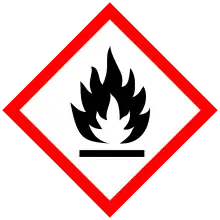 | |
| Names | |
|---|---|
| Preferred IUPAC name
3-Methylpentan-2-ol | |
| Other names
3-Methyl-2-pentanol | |
| Identifiers | |
| |
3D model (JSmol) |
|
| ChEBI | |
| ChemSpider | |
| ECHA InfoCard | 100.008.438 |
| EC Number |
|
PubChem CID |
|
CompTox Dashboard (EPA) |
|
| |
| |
| Properties | |
| C6H14O | |
| Molar mass | 102.174 g/mol |
| Appearance | colorless liquid |
| Density | 0.8307 g/cm3 at 20 °C |
| Boiling point | 134.3 °C (273.7 °F; 407.4 K) |
| 19 g/L | |
| Solubility | soluble in ethanol, diethyl ether |
| Thermochemistry | |
Heat capacity (C) |
275.9 J·mol−1·K−1 (liquid) |
| Hazards | |
| GHS labelling: | |
  | |
| Warning | |
| H226, H319 | |
| P210, P233, P240, P241, P242, P243, P264, P280, P303+P361+P353, P305+P351+P338, P337+P313, P370+P378, P403+P235, P501 | |
| Related compounds | |
Related compounds |
Hexanol |
Except where otherwise noted, data are given for materials in their standard state (at 25 °C [77 °F], 100 kPa).
Infobox references | |
3-Methyl-2-pentanol (IUPAC name: 3-methylpentan-2-ol) is an organic chemical compound. It has been identified as a component of hops.[2] Its presence in urine can be used to test for exposure to 3-methylpentane.[3]
References
- ↑ Lide, David R. (1998), Handbook of Chemistry and Physics (87 ed.), Boca Raton, Florida: CRC Press, pp. 3–398, 5–47, 8–106, ISBN 0-8493-0594-2
- ↑ Jackson, John F.; Linskens, Hans F. (2002), Analysis of taste and aroma, Springer, p. 83, ISBN 978-3-540-41753-8, retrieved 2010-01-22
- ↑ Lauwerys, Robert R.; Hoet, Perrine (2001), Industrial chemical exposure: guidelines for biological monitoring, CRC Press, p. 190, ISBN 978-1-56670-545-5, retrieved 2010-01-22
This article is issued from Wikipedia. The text is licensed under Creative Commons - Attribution - Sharealike. Additional terms may apply for the media files.